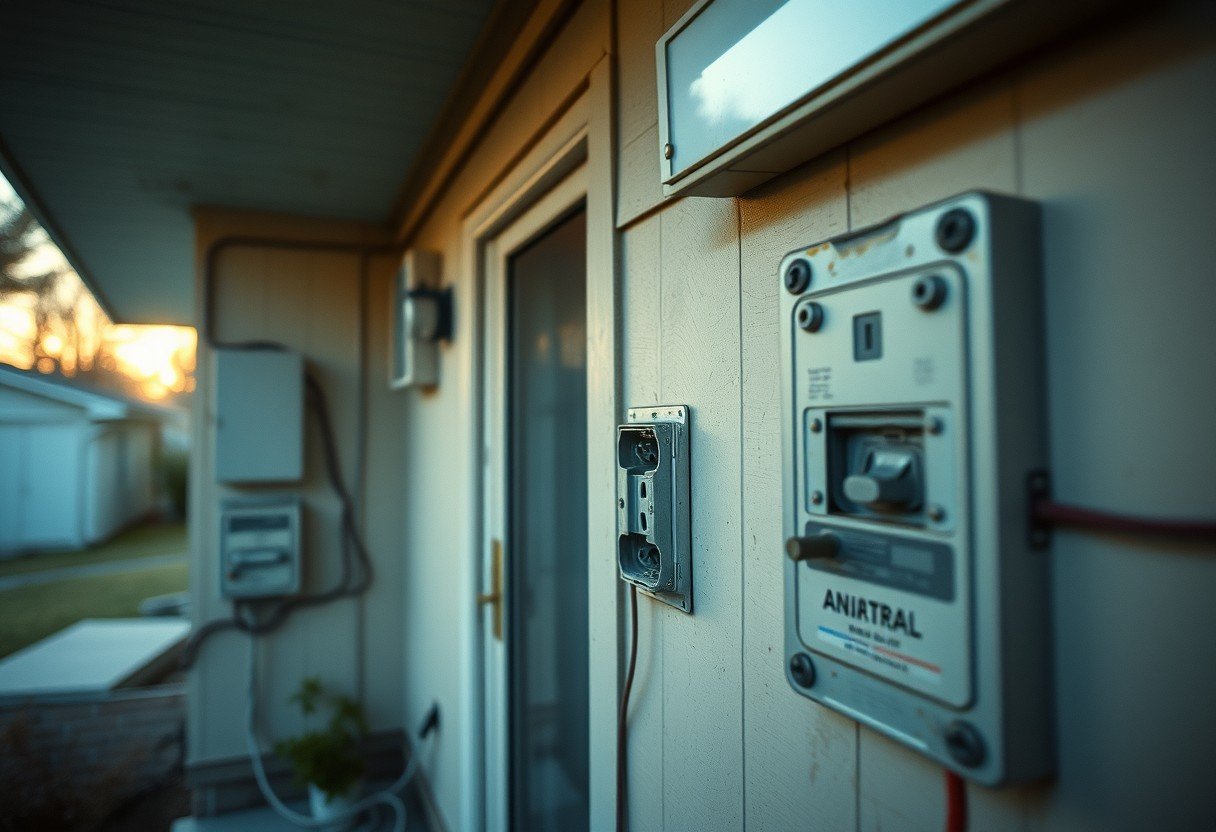If you live in a home built between 1960 and 1970, you might be wondering about the state of your electrical system. During this era, wiring standards were different, and materials that are now considered risky, like aluminum, were common. Understanding these older systems is crucial for ensuring your home is safe, can handle modern appliances, and meets current electrical codes. This guide will help you identify the signs that your vintage home may need an electrical update.
Why is Wiring from the 1960s and 70s a Concern?
Electrical systems in homes from this period represent a major transition in building practices. While many of these homes are full of character, their wiring might not be up to the task of powering a 21st-century household safely. The primary concerns stem from the materials used and the capacity of the original system.
One of the biggest issues is the widespread use of aluminum wiring instead of copper, especially from the mid-1960s to the early 1970s. Aluminum was cheaper at the time, but it expands and contracts more than copper when it heats up and cools down. This can cause connections at outlets, switches, and the breaker box to become loose over time, creating a serious fire hazard.
Furthermore, many of these homes were built with a 60-amp electrical service. Today, the standard is typically 150 or 200 amps. A 60-amp service simply cannot safely support the combined load of modern appliances like central air conditioning, electric dryers, high-definition TVs, and multiple computers. This can lead to constant overloading and potential damage to your electrical system.
Telltale Signs Your Home Needs a Rewiring Job
You don’t need to be an electrician to spot the warning signs of an outdated or failing electrical system. These symptoms are your home’s way of telling you it’s time for a professional inspection. Ignoring them can lead to dangerous situations.
Pay close attention to how your home’s electricity behaves during daily use. Some signs are obvious annoyances, while others are more subtle but just as serious.
Here are some key indicators that your house may need rewiring:
- Frequent Circuit Breaker Trips: If you constantly have to go to the breaker box to reset a circuit, it means the circuit is overloaded. This is a strong sign your system can’t handle your power needs.
- Flickering or Dimming Lights: Lights that dim when you turn on a large appliance, like a microwave or vacuum, suggest the circuit is strained. Constant flickering can also point to loose or faulty wiring.
- Warm or Discolored Outlets: An outlet or switch plate that is warm or hot to the touch is a major red flag. This indicates a problem with the wiring connection that could lead to a fire. Any discoloration or scorching is also a sign of dangerous overheating.
- A Persistent Burning Smell: A faint burning smell, often described as fishy or like burning plastic, can signal that wire insulation is overheating somewhere in your walls. If you notice this smell, you should contact an electrician immediately.
The Hidden Dangers of Outdated Electrical Systems
Living with old wiring is not just an inconvenience; it’s a significant safety risk. The two biggest dangers are electrical fires and the risk of electrocution. According to the U.S. Fire Administration, electrical malfunctions are a leading cause of house fires each year, and many of these are linked to aging wiring.
Faulty wiring, especially deteriorating insulation and loose aluminum connections, can create sparks inside your walls that ignite surrounding materials like wood and insulation. These fires can start and spread quickly, often without any warning. Overloaded circuits also cause wires to overheat, melting their protective plastic coating and dramatically increasing the risk of a fire.
Beyond fire hazards, damaged or exposed wires create a serious risk of electrical shock. As insulation becomes brittle with age, it can crack or flake off, leaving live wires exposed within walls or at outlets. This poses a severe danger to anyone in the home, especially children or anyone performing DIY repairs without being aware of the wiring’s condition.
What are the Benefits of a Full Home Rewire?
While rewiring your home is a significant undertaking, the benefits to your safety, property value, and daily life are immense. It’s an investment that provides peace of mind and modern convenience.
First and foremost, the primary benefit is improved safety. By replacing old wiring, you eliminate the risks of electrical fires and shocks associated with outdated materials and overloaded systems. A new electrical system will be fully compliant with modern safety codes, which is also often a requirement for obtaining or maintaining homeowner’s insurance on an older property.
A newly rewired home is also much more attractive to potential buyers. An updated electrical system is a major selling point that can significantly increase your home’s value. Buyers are willing to pay more for a home that they know is safe and won’t require expensive and disruptive electrical work in the near future.
Finally, you’ll experience enhanced electrical efficiency. Modern wiring and components are more effective at conducting electricity, which means less energy is lost as heat. This can lead to lower monthly utility bills and a more environmentally friendly home. A new system can also support smart home technology, electric vehicle chargers, and other modern innovations.
Understanding the Cost of Rewiring Your House
For most homeowners, the biggest question is about the cost. The price of a full home rewire can vary widely depending on several factors, so it’s important to understand what goes into an estimate. Planning your budget carefully is key to a successful project.
The total cost will depend on the size of your home, how accessible the current wiring is, the materials used, and local labor rates. For example, a home with an open attic or basement is easier and cheaper to rewire than one where electricians need to cut into finished plaster walls.
Always get multiple quotes from licensed electricians to compare costs and services. When budgeting, it’s a smart practice to set aside an extra 10-20% of the total estimate for a contingency fund. This can cover any unexpected issues that might be discovered once the walls are opened up, such as a need for a new electrical panel or repairs to framing.
| Factor | How It Affects Cost |
|---|---|
| Home Size | Larger homes require more materials and labor, increasing the price. |
| Wiring Accessibility | Open basements and attics reduce labor costs. Finished walls and ceilings increase them. |
| Panel Upgrade | If the main electrical panel also needs replacing, this will add to the total cost. |
| Permits and Inspections | Local permit fees are a required part of the budget. |
Hiring the Right Electrician for an Older Home
Rewiring a house is not a DIY project. It is complex, dangerous, and requires a deep understanding of electrical codes. Hiring a qualified and experienced professional is essential for ensuring the job is done safely and correctly.
When searching for an electrician, look for one who is licensed, insured, and has specific experience working on older homes from the 1960s and 1970s. These professionals will be familiar with common issues like aluminum wiring and can provide the best solutions.
Before hiring anyone, be sure to ask the right questions. This will help you find a trustworthy expert who meets your needs and expectations.
- What is your experience with rewiring homes of this age?
- Can you provide proof of your license and insurance?
- Will you provide a detailed, itemized quote for the entire project?
- What is the estimated timeline for the work?
Engaging in this conversation helps build trust and ensures you and your electrician are on the same page before any work begins.
Frequently Asked Questions
How can I tell if my house has aluminum wiring?
An electrician can confirm this for you, but you may be able to see wiring marked with “AL” or “Aluminum” on the plastic sheathing if you look at exposed wires in your attic or basement. Another clue is if your home was built or renovated between 1965 and 1973.
What are the risks of not rewiring an old house?
The primary risks are electrical fires due to overheating connections and overloaded circuits. Other dangers include damage to modern electronics, the potential for electrical shock, and failing to meet current safety codes, which can cause issues with insurance or when selling your home.
How much does it typically cost to rewire a house from this era?
Costs vary based on home size, location, and accessibility, but a full rewire can range from $6,000 to $12,000 or more. The only way to get an accurate figure for your specific home is to get quotes from licensed electricians.
Can I just replace the outlets and switches instead of a full rewire?
Simply replacing devices without addressing the underlying wiring is not a safe solution, especially with aluminum wiring. Special connectors are needed for aluminum, and just changing the outlet won’t fix old, brittle insulation or an overloaded system. A professional assessment is necessary.
How long does a home rewiring project take?
For a typical single-family home, the process can take anywhere from a few days to a full week. The duration depends on the complexity of the job, the size of the house, and whether electricians need to repair walls after running new wires.








Leave a Comment